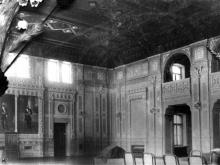The decoration of the assembly hall of the KPI first building, large physical lecture hall of mechanical department and two lobbies adjoining to them continued till autumn of 1901 and it was made in the Romanesque style upon the projects of the architect A. Kobelev. All plastering was performed by a sculpture Elio Sala, whose temporary workshop was in the same building. He also made handrails and balustrades of an artificial stone for a front staircase (according to A. Kobelev's drawings), marble windowsills and inlaid floors in the assembly hall and lobby.
According to the testimony of the architect V. Obremsky, the architect O. Verbitsky was involved in the decoration of the lobby and assembly hall, the architect V. Osmak – in the decoration of physical lecture hall. Front doors were made by the master M. Veyermiller. In March 1901 an artist N. Pimonenko handed over the portraits of the Russian emperors Alexander II and Nicholas II written for the assembly hall. Till the autumn of the same year finishing works were completed.
The assembly hall with two rows of windows (area about 450 sq.m) is bridged by broken into caissons lowered ceiling, the décor of which is simplified relatively to the original version (before the fire in 1914 it was decorated with a molding). Smooth beams of caissons lean on arms. The tectonics of walls is double-deck: below are big arch windows, above - dual rectangular windows, under which the strip of a floral and geometrical ornament stretches. There are openings of entrances (below) on a northern wall. An elegant wide frieze with graceful columns and sockets stretches on the perimeter of the hall. Rectangular windows are framed with groups of Romanesque semi-columns, big arch windows – with archivolts and modelled floral ornament. The doubled interfensteral shovels form vertical segmentations. Canvases with modern painting of allegorical character are placed behind the professorial chair in three niches of the western wall. The floor is parquet. The combination of the Renaissance principles of the general construction and the stylized Romano-Gothic decor is characteristic for architecture of the room.

